
Eero Saarinen was a Finnish-American architect and industrial designer who created a wide array of innovative designs for buildings and monuments, including the General Motors Technical Center in Warren, Michigan; the passenger terminal at Dulles International Airport outside Washington, D.C.; the TWA Flight Center at John F. Kennedy International Airport; and the Gateway Arch in St. Louis. He was the son of Finnish architect Eliel Saarinen.

Southern Finland was a province of Finland from 1997 to 2009. It bordered the provinces of Western Finland and Eastern Finland. It also bordered the Gulf of Finland and Russia.

Hämeenlinna is a city in Finland and the regional capital of Kanta-Häme. It is located in the southern interior of the country and on the shores of Lake Vanajavesi. The population of Hämeenlinna is approximately 68,000, while the sub-region has a population of approximately 94,000. It is the 15th most populous municipality in Finland, and the 14th most populous urban area in the country.

Kotka is a town in Finland, located on the southeastern coast of the country at the mouth of the Kymi River. The population of Kotka is approximately 50,000, while the sub-region has a population of approximately 79,000. It is the 21st most populous municipality in Finland, and the 16th most populous urban area in the country.

Kouvola is a city in Finland and the administrative capital of Kymenlaakso. It is located in the southeastern interior of the country. The population of Kouvola is approximately 79,000. It is the 11th most populous municipality in Finland, and the 17th most populous urban area in the country.
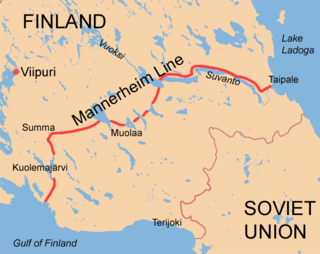
The Mannerheim Line was a defensive fortification line on the Karelian Isthmus built by Finland against the Soviet Union. While this was never an officially designated name, during the Winter War it became known as the Mannerheim Line, after Finnish Army's then commander-in-chief Field Marshal Baron Carl Gustaf Emil Mannerheim. The line was constructed in two phases: 1920–1924 and 1932–1939. By November 1939, when the Winter War began, the line was by no means complete.
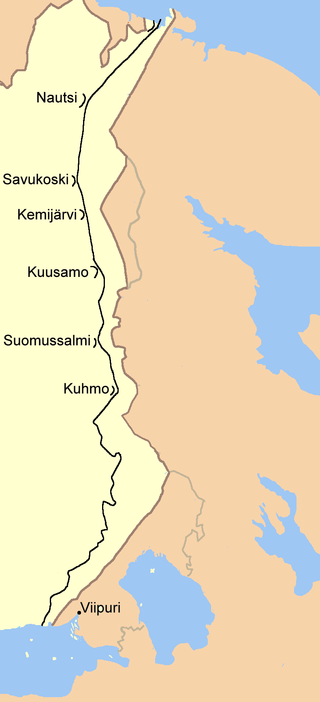
The Salpa Line, or its official name, Suomen Salpa, is a bunker line on the eastern border of Finland. It was built in 1940–1941 during the Interim Peace between the Winter War and the Continuation War and further in 1944 to defend Finland against a possible Soviet invasion.

Häme Castle or Tavastia Castle is a medieval castle in Tavastia Proper, Finland. It is located in Hämeenlinna, the city between Helsinki and Tampere. Originally located on an island, the castle now sits on the coast of lake Vanajavesi. The castle consists of a central keep and surrounding curtain walls, enclosed by a moat. The keep originally had five turrets, but only two are apparent today. The curtain wall has a gatehouse, battlements, an octagonal brick corner turret, and a round gun turret. The lower tiers of the keep and curtain wall are of masoned granite and the upper tiers are red brickwork.

Karelia Brigade is one of the three Finnish Army readiness brigades. It is currently based at Valkeala. With some three thousand soldiers it is the second largest brigade in Finland. It is the only Finnish brigade providing training in all Army branches and houses the Finnish Defence Forces Explosive Ordnance Disposal Centre of Excellence. As of 2023, its commander is brigadier general Jyri Raitasalo.

The Vyborg–Petrozavodsk offensive or Karelian offensive was a strategic operation by the Soviet Leningrad and Karelian Fronts against Finland on the Karelian Isthmus and East Karelia fronts of the Continuation War, on the Eastern Front of World War II. The Soviet forces captured East Karelia and Vyborg/Viipuri. After that, however, the fighting reached a stalemate.

The Lahti railway station is located in the city of Lahti in Finland.

Viipuri Province was a historical province of Finland from 1812 to 1945.
The history of rail transport in Finland began on January 31, 1862, with the opening of the railway line between Helsinki and Hämeenlinna. By 1900 most of the future main lines had been constructed, including the line to St. Petersburg. By the time of the birth of the new Finnish Republic in 1917 lines connected all major cities, major ports, and reached as far as the Swedish border, and inner Finland as far north as Kontiomäki in Paltamo region, as well as eastwards into Karelia.

The Artillery Museum of Finland is a special military museum dedicated to the history of the artillery from the 15th century to the present day. It was located in Niinisalo from 1977 to 1997. In 1997 it was relocated to Hämeenlinna.

James Hirvisaari is a Finnish politician. He was elected to the Finnish Parliament in the 2011 general election held on 17 April on the electoral list of the Finns Party, but since 2013 he has represented Change 2011.
The Salpa Line Museum was established and opened in 1987 by the municipality of Miehikkälä and by World War II veteran organisations. It is the first museum established in Miehikkälä. The other museums are the Miehikkälän kotiseutumuseo and the Miehikkälä local arts and crafts museum, which was established in 1989 and is located in the same building as the Engineers Museum.
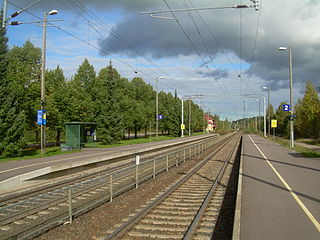
The Herrala railway station is located in Hollola, Finland, in the village and urban area of Herrala. It is located along the Riihimäki–Lahti line, and its neighboring stations are Järvelä in the west and Lahti in the east.
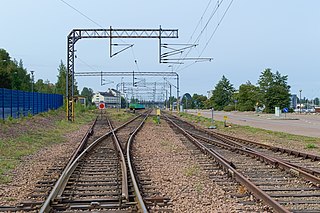
The Kouvola–Kotka railway, also called the Kotka railway is a 1,524 mm railway in Finland, connecting the towns of Kouvola and Kotka in the region of Kymenlaakso.
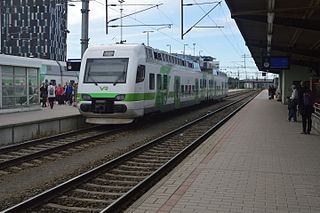
VR commuter rail is a Finnish commuter rail system operated by VR – the national railway operator of Finland – under a public service obligation agreement with the Ministry of Transport and Communications of Finland. The operations are planned in trilateral co-operation between the ministry, the operator and various regional transport authorities.


















